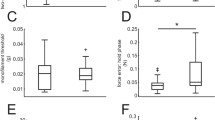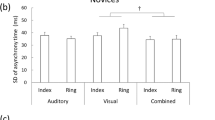Abstract
Sequential actions such as playing a piano or tapping in synchrony to an external signal put high cognitive and motor demands on producers, including the generation of precise timing at a wide variety of rates. Tactile information from the fingertips has been shown to contribute to the control of timing in finger tapping tasks. We addressed the hypothesis that reduction of timing errors is related to tactile afferent information in pianists’ finger movements during performance. Twelve pianists performed melodies at four rates in a synchronization-continuation paradigm. The pianists’ finger motion trajectories toward the piano keys, recorded with a motion capture system, contained different types and amounts of kinematic landmarks at different performance rates. One landmark, a finger–key (FK) landmark, can occur when the finger makes initial contact with the key surface and changes its acceleration abruptly. Overall, there were more FK landmarks in the pianists’ keystrokes, as the performance rate increased. The pianists were divided into two groups: those with low percentages of FK in the medium rates that increased with increasing performance rate and those with persistently high FK percentages. Low-FK pianists showed a positive relationship between increased tactile feedback from the current keystroke and increased temporal accuracy in the upcoming keystroke. These findings suggest that sensory information available at finger–key contact enhances the timing accuracy of finger movements in piano performance.





Similar content being viewed by others
Notes
One participant was 60 years old and had 40 years of piano lessons. To check for possible age effects, this participant’s data were compared with those of the other participants and no significant differences were observed. The mean data reported comprise all participants.
The metronome click audio signal was recorded on the analog input of the Vicon System (a 32-channel Mezzanine card operating at a sampling rate of 10 kHz) and on the digital soundcard (Motu 828 mkII, operating at 44.1 kHz) using Cubase software. The synchronization error of this method was less than 1 ms.
The choice of the time window was made based on measurement data on typical key movement behavior reported in Goebl et al. (2005).
Due to the different n in the two groups, a Tukey-Kramer modification of the HSD test for unequal sample n’s was used (Kirk 1982, p. 119).
All calculations were based on the detrended IOIs. We repeated the timing analyses on log IOIs (Desain and Honing 1994) to account for timing differences across rates. These alternative calculations yielded qualitatively similar results as those reported below.
Goebl et al. (2005) used a similar measure, which they termed “travel time.” It referred to the duration between FK and the actual tone onset (hammer-string contact).
References
Aschersleben G (2002) Temporal control of movements in sensorimotor synchronization. Brain Cogn 48:66–79
Aschersleben G, Prinz W (1995) Synchronizing actions with events: the role of sensory information. Percept Psychophys 57:305–317
Aschersleben G, Gehrke J, Prinz W (2001) Tapping with peripheral nerve block. A role for tactile feedback in the timing of movements. Exp Brain Res 136:331–339
Aschersleben G, Gehrke J, Prinz W (2004) A psychophysical approach to action timing. In: Kaernbach C, Schröger E, Müller H (eds) Psychophysics beyond sensation: laws and invariants. Lawrence Erlbaum, Mahwah, pp 117–136
Askenfelt A, Jansson EV (1990a) From touch to string vibrations. In: Askenfelt A (ed) Five lectures on the acoustics of the piano, vol 64, Royal Swedish Academy of Music, Stockholm, pp 39–57
Askenfelt A, Jansson EV (1990b) From touch to string vibrations. I. Timing in the grand piano action. J Acoust Soc Am 88:52–63
Askenfelt A, Jansson EV (1992) On vibration and finger touch in stringed instrument playing. Music Percept 9:311–350
Balasubramaniam R (2006) Trajectory formation in timed repetitive movements. In: Latash ML, Lestienne F (eds) Motor control and learning. Springer, New York, pp 47–54
Balasubramaniam R, Wing A, Daffertshofer A (2004) Keeping with the beat: movement trajectories contribute to movement timing. Exp Brain Res 159:129–134
Báron JG (1958) Physical basis of piano touch. J Acoust Soc Am 30:151–152
Billon M, Semjen A, Cole J, Gauthier G (1996) The role of sensory information in the production of periodic finger-tapping sequences. Exp Brain Res 110:117–130
Desain P, Honing H (1994) Does expressive timing in music performance scale proportionally with tempo? Psychol Res 56:285–292
Finney SA, Palmer C (2003) Auditory feedback and memory for music performance: sound evidence for an encoding effect. Mem Cognit 31:51–64
Fisher RJ, Galea MP, Brown P, Lemon RN (2002) Digital nerve anaesthesia decreases EMG–EMG coherence in a human precision grip task. Exp Brain Res 145:207–214
Flanagan JR, Johansson RS (2002) Hand movements. In: Ramashandran VS (ed) Encyclopedia of the human brain, vol 2. Academic Press, San Diego, pp 399–414
Fraisse P (1980) Les synchronisation sensoir-motrices aux rythmes. [The sensorimotor synchronization of rhythms]. In: Requin J (ed) Anticipation et comportement (Anticipation and behaviour). Centre National de la Recherche Scientifique, Paris, pp 233–257
Gentilucci M, Toni I, Daprati E, Gangitano M (1997) Tactile input of the hand and the control of reaching to grasp movements. Exp Brain Res 114:130–137
Goebl W (2001) Melody lead in piano performance: Expressive device or artifact? J Acoust Soc Am 110:563–572
Goebl W, Bresin R (2003) Measurement and reproduction accuracy of computer-controlled grand pianos. J Acoust Soc Am 114:2273–2283
Goebl W, Bresin R, Galembo A (2005) Touch and temporal behavior of grand piano actions. J Acoust Soc Am 118:1154–1165
Gordon AM, Soechting JF (1995) Use of tactile afferent information in sequential finger movements. Exp Brain Res 107:281–292
Jerde TE, Santello M, Flanders M, Soechting JF (2006) Hand movements and musical performance. In: Altenmüller E, Kesselring J, Wiesendanger M (eds) Music, motor control and the brain. Oxford University Press, Oxford, pp 79–90
Jones L (1996) Proprioception and its contribution to manual dexterity. In: Wing A, Haggard P, Flanagan JR (eds) Hand and brain. The neurophysiology and psychology of hand movements. Academic Press, San Diego, pp 349–362
Kinoshita H, Furuya S, Aoki T, Altenmüller E (2007) Loudness control in pianists as exemplified in keystroke force measurements on different touches. J Acoust Soc Am 121:2959–2969
Kirk RE (1982) Experimental design: procedures for the behavioral sciences. Brooks/Cole, Belmont
Koornhof GW, van der Walt AJ (1994) The influence of touch on piano sound. In: Friberg A, Iwarsson J, Jansson EV, Sundberg J (eds) Proceedings of the Stockholm Music Acoustics Conference (SMAC’93), 28 July–1 August 1993, vol 79. The Royal Swedish Academy of Music, Stockholm, pp 302–308
Loehr JD, Palmer C (2007) Cognitive and biomechanical influences in pianists’ finger tapping. Exp Brain Res 178:518–528
MacKenzie CL, Van Eerd DL (1990) Rhythmic precision in the performance of piano scales: motor psychophysics and motor programming. In: Jeannerod M (ed) Attention and performance, vol XIII. Lawrence Erlbaum, Hillsdale, pp 375–408
Ortmann O (1925) The physical basis of piano touch and tone. Paul K, Trench, Trubner, Curwen J (eds) E. P. Dutton, London
Palmer C (1989) Mapping musical thought to musical performance. J Exp Psychol Hum Percept Perform 15:331–346
Palmer C, Dalla Bella S (2004) Movement amplitude and tempo change in piano performance. J Acoust Soc Am 115:2590
Palmer C, Pfordresher PQ (2003) Incremental planning in sequence production. Psychol Rev 110:683–712
Pfordresher PQ, Palmer C (2002) Effects of delayed auditory feedback on timing of music performance. Psychol Res 66:71–79
Rabin E, Gordon AM (2004) Tactile feedback contributes to consistency of finger movements during typing. Exp Brain Res 155:362–369
Ramsay JO, Silverman BW (2005) Functional Data Analysis. Springer, New York
Repp BH (2005) Sensorimotor synchronization: a review of the tapping literature. Psychon Bull Rev 12:969–992
Repp BH (2006) Musical synchronization. In: Altenmüller E, Kesselring J, Wiesendanger M (eds) Music, motor control and the brain. Oxford University Press, Oxford, pp 55–75
Schmidt RA, Lee TD (1999) Motor control and learning. Human kinetics, Champaign
Soechting JF, Gordon AM, Engel KC (1996) Sequential hand and finger movements: typing and piano playing. In: Bloedel JR, Ebner TJ, Wise SP (eds) The acquisition of motor behavior in vertebrates. MIT, Cambridge, pp 343–360
Stenneken P, Prinz W, Cole J, Paillard J, Aschersleben G (2006) The effect of sensory feedback on the timing of movements: evidence from deafferented patients. Brain Res 1084:123–131
Todd NPM (1992) The dynamics of dynamics: a model of musical expression. J Acoust Soc Am 91:3540–3550
White WB (1930) The human element in piano tone production. J Acoust Soc Am 1:357–367
Zelaznik HN, Spencer RM, Ivry RB (2002) Dissociation of explicit and implicit timing in repetitive tapping and drawing movements. J Exp Psychol Hum Percept Perform 28:575–588
Acknowledgments
This work was supported by an Erwin-Schrödinger fellowship of the Austrian Science Fund (J2526) to the first author, and by the Canada Research Chairs program and NSERC Grant 298173 to the second author. We thank Marcelo Wanderley and Jim Ramsay for their assistance and fruitful discussions, as well as Erik Koopmans and Jad Salameh for their assistance.
Author information
Authors and Affiliations
Corresponding author
Rights and permissions
About this article
Cite this article
Goebl, W., Palmer, C. Tactile feedback and timing accuracy in piano performance. Exp Brain Res 186, 471–479 (2008). https://doi.org/10.1007/s00221-007-1252-1
Received:
Accepted:
Published:
Issue Date:
DOI: https://doi.org/10.1007/s00221-007-1252-1




